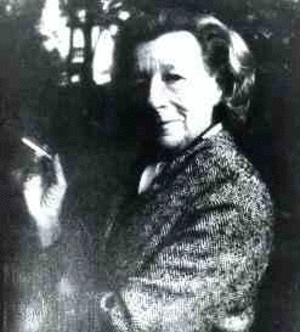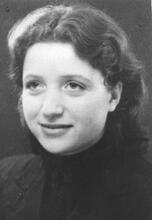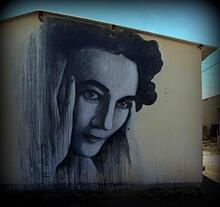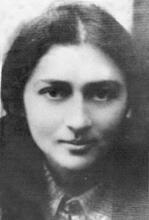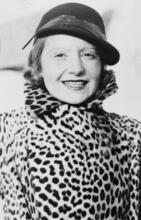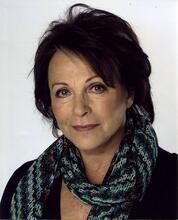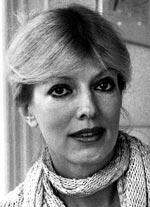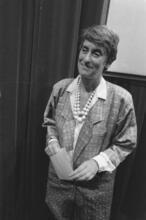Lillian Hellman
Lillian Hellman displayed courage not only in writing powerful and controversial plays like The Children’s Hour but also in her public refusal to name colleagues to the House Un-American Activities Committee. Hellman worked for the Boni and Liveright publishing house before moving to Hollywood to become a writer for Sam Goldwyn. In 1934, her first play, The Children’s Hour, was met with both wild success and widespread criticism. She had a relationship with mystery writer Dashiell Hammett, with whom she became involved in left-wing activism. Called before HUAC in 1952, Hellman wrote an eloquent letter declining to testify because she refused to name friends and colleagues to the committee. Hellman was blacklisted for several years but returned to writing in the 1960s.
Lillian Hellman’s father once referred to her as the “Jewish nun of Prytania Street,” a description that aptly suggests the complexity of her life and of her relationship to Judaism and Jewish culture. Both as a writer and in her private life, Hellman lived out many contradictory roles, some of which, the historical record and her contemporaries suggest, may well have been self-invented, blurring the lines between biography and art in her own presentation of self. Controversial both during and after her life, Lillian Hellman is one of the leading women of letters of mid-century America and a pioneer in the area of women as playwrights. Some corners of her life will probably always remain clouded and impossible to verify, an irony in a woman for whom questions of ethics and truth-telling were recurrent themes in her plays and memoirs.
Early Life and Family
Lillian Hellman was born on June 20, 1905, in New Orleans, Louisiana. Her parents, Max and Julia (Newhouse) Hellman, were both German-American Jews. Her mother’s family was wealthy and later became the models (though stripped of Jewish identity) for Hellman’s most famous creations, the Hubbards, in her two plays The Little Foxes and Another Part of the Forest. Max Hellman’s sisters Hannah and Jenny were similarly the basis for the central characters in one of Hellman’s last plays, Toys in the Attic.
In 1911, when Max’s shoe business failed, the Hellmans left New Orleans and moved to New York City. From the time Lillian Hellman was eleven until she was sixteen, the family divided its time between New Orleans and New York City, giving the young girl a sense of always belonging to multiple cultures. She attended New York University for a time and in 1924 went to work for the prestigious publishing house Boni and Liveright. The following year, she married the writer Arthur Kober. Five years later, they moved to Hollywood, where Kober was employed as a screenwriter. Hellman also found work in the fledgling sound film industry, working first as a reader and later as a writer for the legendary mogul Sam Goldwyn. The marriage between Kober and Hellman, her only legal marriage, ended in divorce.
Career as a Playwright
During the 1930s, Hellman began to write plays. Her first produced play, The Children’s Hour (1934), would also prove to be her most controversial. In it, Hellman explored the effects of a lie, spread as gossip, in a small New England town. What produced controversy was the nature of the lie: a little girl taking revenge on two teachers at a private school by telling her grandmother that they were lesbians. Though the rumor is groundless, it causes financial ruin for the women and results in one of them, Martha, questioning her own sexuality and killing herself in the last act of the play. Discussion, let alone representation, of homosexuality onstage and in film was then close to taboo (indeed, the play was banned in many cities) and was, according to critics of the time, the primary reason the play was denied the Pulitzer Prize for best drama of the year. Interestingly, in 1936, Sam Goldwyn filmed the play as These Three, omitting all references to lesbianism and turning the lie into one suggesting a romantic triangle between the two women and the doctor who is engaged to one of them. While some felt that such an alteration removed the play’s power, others (Hellman included) felt that it maintained the central focus of the play: the power of a lie to destroy lives.
Hellman continued to write and produce plays throughout the next three decades, including some of the greatest critical and popular successes of the Broadway stage. Virtually all of the plays were “well made,” following in the realistic and naturalistic traditions of such dramatists as Henrik Ibsen and Anton Chekhov. Hellman shares with Ibsen a concern for the drama as a representation of social problems and as a keen insight into the psyche and power of women in societies that restrict their political and economic power. With Chekhov, she shares the craft of dramatizing the complex orchestrations of families and small towns. Her most important plays, in addition to The Children’s Hour, include The Little Foxes and Another Part of the Forest, which follow the machinations of the Hubbard family in the antebellum South. In these two plays, she creates her most memorable and lasting character, Regina Hubbard Giddens, a virago descended from such prototypes as Medea and Lady Macbeth, played by such disparate actors as Tallulah Bankhead (who originated the role in Foxes on Broadway), Bette Davis (who transferred the role to film), and Elizabeth Taylor. Of such epic proportions were the Hubbards that The Little Foxes was translated into opera form by Marc Blitzstein, as Regina.
Other plays include her World War II dramas Watch on the Rhine (1941) and the less memorable The Searching Wind (1944). The Autumn Garden (1951), which Hellman and many critics believed to be her finest play; and Toys in the Attic (1960), in which she returned to family material. Hellman won the New York Drama Critics Award for both Watch on the Rhine and Toys in the Attic. Hellman also adapted foreign plays as well as novels for the stage.
Personal Life and Political Involvement
Throughout Hellman’s career as a playwright, her “offstage” life was lively and dramatic as well. During the 1920s and 1930s, she took a number of trips to Europe—trips which raised her political awareness. What actually occurred on these trips is the source of much debate. In her memoirs, particularly in the section of Pentimento called “Julia,” Hellman depicted herself as a participant in anti-Nazi work. Recent biographers have called into question the identity of “Julia” (a pseudonym in Hellman’s writings) and Hellman’s actual participation in underground activities. The questions remain unanswered, and perhaps will always remain unanswered as presumably most of the principals involved have died.
Though Hellman never remarried after her divorce from Kober, she sustained a complex, passionate, and tempestuous relationship with the mystery writer Dashiell Hammett from 1930 until his death in 1961. The two of them, individually and together, became important figures in left-wing literary and intellectual circles, with Hellman in particular becoming a noted pro-Stalinist. Indeed, their left-wing activities led to Hellman’s being blacklisted from Hollywood in 1948, during the first years of the witch hunts led by Senator Joseph McCarthy. She was called to testify before the House Un-American Activities Committee (HUAC) in 1952. In a letter that has now become famous as one of the most articulate and eloquent responses to McCarthyism, Hellman declined to testify, not out of fear for her own safety or her own unwillingness to speak of her beliefs or activities, but because she could not name her friends and coworkers and still keep her self-respect. In an era when many other writers and actors did name “fellow travelers” in order to exculpate themselves, Hellman’s stand was considered a brave one at the time, though it came under considerable revision in later years, particularly after Hellman’s presentation of it in her third memoir, Scoundrel Time. Contemporaries of Hellman’s, such as Diana Trilling, Irving Howe, and Mary McCarthy, questioned what they saw as Hellman’s revision of her actual participation in pro-Stalinist work and of her self-congratulatory stance toward her actions during the HUAC hearings.
Despite such revisionism, Hellman was lionized in later years, particularly after the publication of her memoirs. Her first memoir, An Unfinished Woman (1969), won the National Book Award. She subtitled her later memoir, Maybe (1980), “A Story,” but it seems clearly autobiographical, at least in part.
Judaism in Hellman’s Life
The importance of Judaism and Jewish culture in Hellman’s life is ambiguous. She rarely wrote about Jewish themes in her plays and certainly never from the stance of an observant Jew. To the extent that leftist intellectual liberalism has been marked by a Jewish presence, Hellman fits into that tradition comfortably. In her memoirs, she addresses her Jewish heritage as part of a cultural background. Even here, she notes that the fact of her Jewishness didn’t fully hit her until she was confronted with antisemitism in the national socialism of Germany during a trip there in 1929. Being a woman and being a southerner seemed more important texts of identity for Hellman than being Jewish. In interviews, she remarked that southern Jews tended to downplay their Jewishness. If one only read Hellman’s plays, one would not necessarily guess that she was Jewish. And, while her memoirs do address this part of her identity, it is clear that Jewish life was not central to her sense of self, at least the self that was an artist and the self that she constructed in her memoirs. Indeed, Meyer Levin felt that Hellman was instrumental in blocking the production of his dramatization of Anne Frank: The Diary of a Young Girl because Levin’s play was “too Jewish” in its depiction of Jewish religious practices and in its articulation of Anne Frank’s Zionist sympathies.
Legacy
Lillian Hellman remains a complicated figure in the history of Jewish American women. Her contributions to the arts of drama and memoir are significant and lasting. Her successes as a professional playwright at a time when that arena was dominated almost exclusively by men were considerable. However controversial, her presence in the world of ideas and politics of the times is undeniable. But the degree to which she brought her identity as a Jew to bear on either her art or her life must remain a question open to debate.
Lillian Hellman died on Martha’s Vineyard, on June 30, 1984.
Selected Works By Lillian Hellman
Plays
Another Part of the Forest (1947).
The Autumn Garden (1951).
Candide [adaptation] (1956).
The Children’s Hour (1934).
Days to Come (1936).
The Lark [adaptation] (1956).
The Little Foxes (1939).
Montserrat (1950).
My Mother, My Father, and Me [adaptation] (1963).
The Searching Wind (1944).
Toys in the Attic (1960).
Watch on the Rhine (1941).
Books
The Collected Plays (1972).
Conversations with Lillian Hellman. Edited by Jackson R. Bryer (1986).
Eating Together, with Peter Feibleman (1984).
Maybe: A Story (1980).
Pentimento (1973).
Scoundrel Time (1976).
An Unfinished Woman (1969).
Adams, Timothy Dow. Telling Lies in Modern American Autobiography (1990).
AJYB 86:440.
Bills, Steven. Lillian Hellman: An Annotated Bibliography (1979).
Chinoy, Helen Kritch, and Linda Walsh Jenkins, eds. Women in American Theatre. Rev. ed. (1987).
EJ; Estrin, Mark W., ed. Critical Essays on Lillian Hellman (1989).
Falk, Doris V. Lillian Hellman (1978).
Feibleman, Peter S. Lilly: Reminiscences of Lillian Hellman (1988).
Gillin, Edward. “‘Julia’ and Julia’s Son.” Modern Language Studies 19, no. 2 (1989): 3–11.
Graver, Lawrence. An Obsession with Anne Frank: Meyer Levin and the Diary (1995).
Grossman, Anita Susan. “Art Versus Truth in Autobiography: The Case of Lillian Hellman.” CLIO 14 (1985): 289–308.
Henderson, Bruce. “Lillian Hellman.” In Jewish American Women Writers, edited by Ann R. Shapiro (1994).
Lederer, Katherine. Lillian Hellman (1979).
Lyons, Bonnie. “Lillian Hellman: ‘The First Jewish Nun of Prytania Street.’” In From Hester Street to Hollywood: The Jewish-American Stage and Screen, edited by Sarah Blacher Cohen (1983).
Riordan, Mary Marguerite. Lillian Hellman: A Bibliography, 1926–1978 (1980).
Rollyson, Carl E. Lillian Hellman: Her Legend and Her Legacy (1988).
UJE; Wright, William. Lillian Hellman: The Image, the Woman (1986).
WWIAJ (1938).
WWWIA 8.

